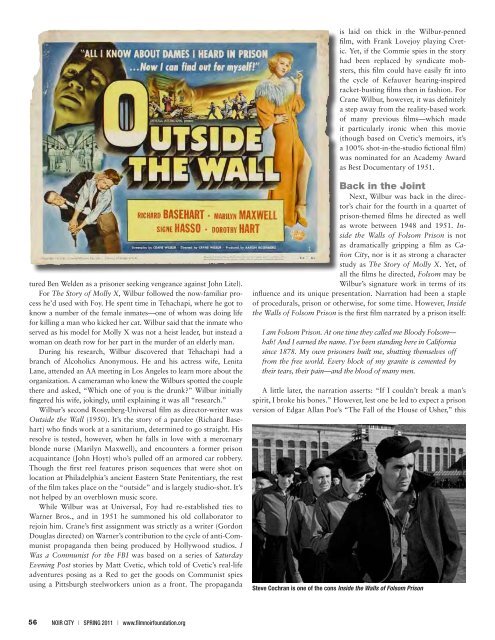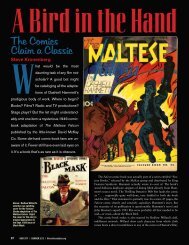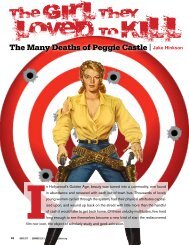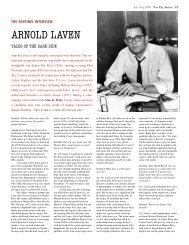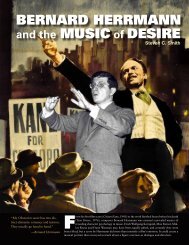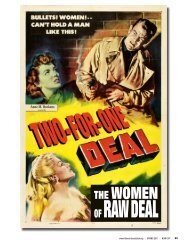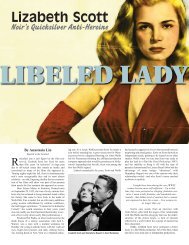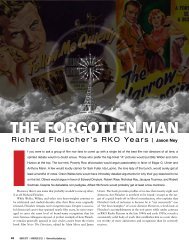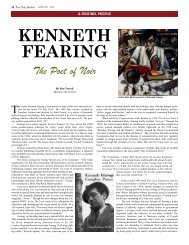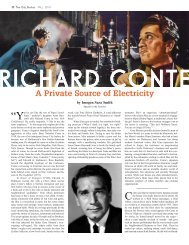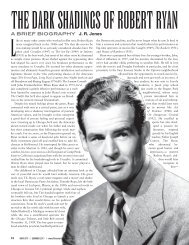Crane Wilbur - Film Noir Foundation
Crane Wilbur - Film Noir Foundation
Crane Wilbur - Film Noir Foundation
You also want an ePaper? Increase the reach of your titles
YUMPU automatically turns print PDFs into web optimized ePapers that Google loves.
tured Ben Welden as a prisoner seeking vengeance against John Litel).<br />
For The Story of Molly X, <strong>Wilbur</strong> followed the now-familiar process<br />
he’d used with Foy. He spent time in Tehachapi, where he got to<br />
know a number of the female inmates—one of whom was doing life<br />
for killing a man who kicked her cat. <strong>Wilbur</strong> said that the inmate who<br />
served as his model for Molly X was not a heist leader, but instead a<br />
woman on death row for her part in the murder of an elderly man.<br />
During his research, <strong>Wilbur</strong> discovered that Tehachapi had a<br />
branch of Alcoholics Anonymous. He and his actress wife, Lenita<br />
Lane, attended an AA meeting in Los Angeles to learn more about the<br />
organization. A cameraman who knew the <strong>Wilbur</strong>s spotted the couple<br />
there and asked, “Which one of you is the drunk?” <strong>Wilbur</strong> initially<br />
fingered his wife, jokingly, until explaining it was all “research.”<br />
<strong>Wilbur</strong>’s second Rosenberg-Universal film as director-writer was<br />
Outside the Wall (1950). It’s the story of a parolee (Richard Basehart)<br />
who finds work at a sanitarium, determined to go straight. His<br />
resolve is tested, however, when he falls in love with a mercenary<br />
blonde nurse (Marilyn Maxwell), and encounters a former prison<br />
acquaintance (John Hoyt) who’s pulled off an armored car robbery.<br />
Though the first reel features prison sequences that were shot on<br />
location at Philadelphia’s ancient Eastern State Penitentiary, the rest<br />
of the film takes place on the “outside” and is largely studio-shot. It’s<br />
not helped by an overblown music score.<br />
While <strong>Wilbur</strong> was at Universal, Foy had re-established ties to<br />
Warner Bros., and in 1951 he summoned his old collaborator to<br />
rejoin him. <strong>Crane</strong>’s first assignment was strictly as a writer (Gordon<br />
Douglas directed) on Warner’s contribution to the cycle of anti-Communist<br />
propaganda then being produced by Hollywood studios. I<br />
Was a Communist for the FBI was based on a series of Saturday<br />
Evening Post stories by Matt Cvetic, which told of Cvetic’s real-life<br />
adventures posing as a Red to get the goods on Communist spies<br />
using a Pittsburgh steelworkers union as a front. The propaganda<br />
56 noir citY i SPrinG 2011 i www.filmnoirfoundation.org<br />
is laid on thick in the <strong>Wilbur</strong>-penned<br />
film, with Frank Lovejoy playing Cvetic.<br />
Yet, if the Commie spies in the story<br />
had been replaced by syndicate mobsters,<br />
this film could have easily fit into<br />
the cycle of Kefauver hearing-inspired<br />
racket-busting films then in fashion. For<br />
<strong>Crane</strong> <strong>Wilbur</strong>, however, it was definitely<br />
a step away from the reality-based work<br />
of many previous films—which made<br />
it particularly ironic when this movie<br />
(though based on Cvetic’s memoirs, it’s<br />
a 100% shot-in-the-studio fictional film)<br />
was nominated for an Academy Award<br />
as Best Documentary of 1951.<br />
Back in the Joint<br />
Next, <strong>Wilbur</strong> was back in the director’s<br />
chair for the fourth in a quartet of<br />
prison-themed films he directed as well<br />
as wrote between 1948 and 1951. Inside<br />
the Walls of Folsom Prison is not<br />
as dramatically gripping a film as Cañon<br />
City, nor is it as strong a character<br />
study as The Story of Molly X. Yet, of<br />
all the films he directed, Folsom may be<br />
<strong>Wilbur</strong>’s signature work in terms of its<br />
influence and its unique presentation. Narration had been a staple<br />
of procedurals, prison or otherwise, for some time. However, Inside<br />
the Walls of Folsom Prison is the first film narrated by a prison itself:<br />
I am Folsom Prison. At one time they called me Bloody Folsom—<br />
hah! And I earned the name. I’ve been standing here in California<br />
since 1878. My own prisoners built me, shutting themselves off<br />
from the free world. Every block of my granite is cemented by<br />
their tears, their pain—and the blood of many men.<br />
A little later, the narration asserts: “If I couldn’t break a man’s<br />
spirit, I broke his bones.” However, lest one be led to expect a prison<br />
version of Edgar Allan Poe’s “The Fall of the House of Usher,” this<br />
Steve Cochran is one of the cons Inside the Walls of Folsom Prison


